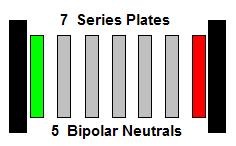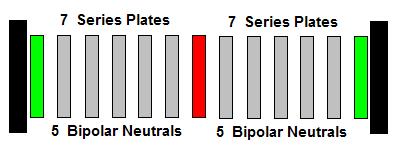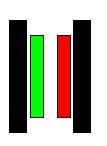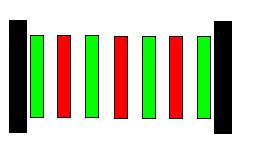|
| |
|
Cell
Configurations |
|
|
|
| |
|
|
|

"Most Popular HHO Configuration" |
This configuration is 1 Stack; a single set of 7 Plates.
- There are 5 Neutral Plates between
the
Negative and the Positive
Unipolar
Plates.
- Unipolar means they have only 1 electrical charge/polarity
(positive or negative).
- Each Neutral is Bipolar; meaning one side is more positive and the other
side is more negative.
- Each of the Neutrals creates a water compartment.
- Each water compartment divides the Operating Voltage in Half.
- 6 water compartments reduce a 12 Volt positive and negative to
2 Volts between adjacent neutral plates.
- Reducing voltage between the plates, extends Cell operating
time...by reducing heat created by amperage ....as it moves from plate
to plate.
- 1 ampere input produces 62.64 ML per
minute of HHO
- 16 amps produces 1.002 Liters per minute
of HHO
|
| |
|

"Most Popular Configuration" |
This configuration is 2 Stacks; 2 sets of 7 Plates.
- Each Stack is sharing the Positive
Plate.
- There are 13 Plates total.
- Each Stack operates independent of the other.
- Voltage between adjacent plates is still 2 Volts; if using a 12
Volt power source.
- Each Stack draws its own amperage.
- Total amperage is measured at the Positive Plate.
- 2 amps input (1 amp per stack) produces
125.28 ML PM of HHO
- 32 amps input (16 amps per stack) produces
2.004 LPM
|
 |
This configuration is 1 Stack; a single set of Plates.
- The 2 Parallel plates are connected to the positive and negative
power source.
- They are Unipolar; meaning they have only one electrical
charge/polarity.
- There is only one water compartment between
positive
and negative.
- Voltage between the plates will always be that of the power
source.
- 1 amp input produces 10.44 ML HHO per
minute
|
| |
|
 |
This configuration is 6 Stacks; 6 sets of 2 Plates; created using 7
plates.
- Each set of plates creates a water compartment.
- Each water compartment is between
positive and negative
plates.
- All plate are Unipolar; connected directly to the power source.
- Each water compartment is a Stack
- Amperage from the power source is divide as it is distributed to
each Stack.
- When using a 12 Volt power source, 12 Volts can be measured
across any positive and negative plate.
- Total amperage can be measured at the battery terminal.
- Heat is controlled by adding many Stacks. Each Stack reduces
amperage flow to other Stacks.
- 1 amp input to each stack (6 amps total)
produces 62.62 ML HHO
- 96 amps will produce 1 LPM of HHO
|
|

"Design - Minimizes Current Leakage" |
This configuration is 3 Stacks of 3 Unipolar Plates.
- Positive and
Negative are separated by 2 groups
of Neutrals. (dark grey set & light grey set)
- Neutrals are Unipolar.
- Using a 12 Volt Power Source, voltage between the Plates would
be reduced to 4 volts.
- 1 amp input produces 31.32 ML HHO
- 1 amp to each Negative produces 62.64 ML
HHO
(Same as 7 Plate Series Stack produced with 1
amp)
|
| |
- Amperage from the Battery divides in half as it travels to the
surface of the 2 Unipolar Negative Plates
- If using 30 Amps, 15A travels across each Negative as it is
attracted towards the more positive Unipolar Neutral Plate between
them.
- 15 amps crosses the water from each Negative and 30 amps is
collected on the first Unipolar Neutral plate of the first Neutral
Plate Group.
- The 30 amps divides again as it is distributed to the other 2
Neutrals in Group 1.
- 15 crosses each of these Group 1 Neutrals, then crosses the
water to Neutral Group 2.
- The first Group 2 Neutral receives 15 amps on each side of the
plate; a total of 30 amps
- Amperage is split again as it is being drawn to the other plates
in Neutral Group 2.
- 15 amps crosses to each side of the Positive plate and heads
towards the Battery.
- This particular configuration uses 9 plates to makes 6 water
compartments for HHO production. It effectively creates 2 Series
Stacks that each have 2 Neutrals between positive and negative.
|
| |
 Number of Plates :
References the difference in efficiency comparing cells with 2, 3, 4, 5,
6, and 7 plates in Series. A chart shows the required amperage needed to
produce 1 LPM of HHO -- for each cell plate configuration. It also shows
the plate voltage, and Current Density needed for Continuous operation.
Number of Plates :
References the difference in efficiency comparing cells with 2, 3, 4, 5,
6, and 7 plates in Series. A chart shows the required amperage needed to
produce 1 LPM of HHO -- for each cell plate configuration. It also shows
the plate voltage, and Current Density needed for Continuous operation. |
|